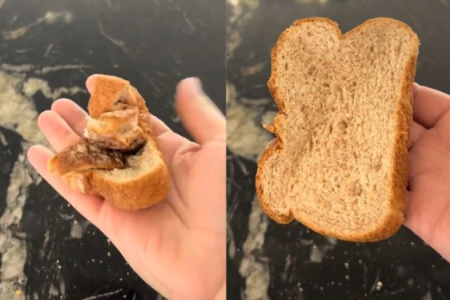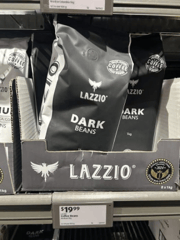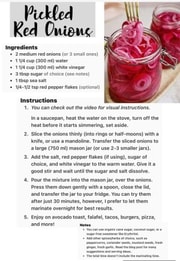You’ve eaten bread all your life—but have the ingredients changed without you knowing?
By
Maan
- Replies 0
A slice of bread that refuses to mould has sparked international disgust.
Australians are recoiling after learning what’s really in the loaves found in American kitchens.
And the viral food trend behind the discovery is almost too bizarre to believe.
In a series of viral social media posts, users showed themselves squishing slices of American bread into tight little balls—only to watch the bread slowly spring back into shape like memory foam.
For many Aussies, the unnatural elasticity was horrifying.
‘In Australia, when you put the bread in the shopping bag at the checkout, it always goes on top because once it’s squished, it’s forever squished,’ wrote one user.
‘In Australia, when you spread Nutella on the slice you rip a hole in it,’ said another.
‘I’m Australian. I accidentally placed a box of tissues on my bread when leaving the grocery store and arrived home to a packet of pita bread,’ added a third.
What made the trend even more alarming was an American woman’s video showing a loaf of bread in her kitchen that had remained mould-free for eight months.
Even US residents joined the outcry, expressing concern over what they’d been unknowingly consuming.
‘As an American who eats American bread, I’m never eating bread ever again,’ wrote one.
‘My bread doesn’t even mould anymore, I can’t remember the last time I saw it happen,’ added another.
‘Is our bread not supposed to do that?,’ questioned a third.
In response to the trend, one curious writer in Australia ran her own experiment using a slice of Helga’s wholemeal bread.
She squished it into a ball, only for it to fall apart into crumbs across her counter.
Although the bread eventually unfurled, she concluded it no longer looked edible.
The experiment raised serious questions about the ingredients used in US bread—particularly the additives banned in much of the world but still permitted in America.
Five common additives found in US bread include Azodicarbonamide (also found in yoga mats), Potassium bromate, Potassium iodate, BHA, and BHT.
Australia, along with many other countries, has banned several of these ingredients due to links with asthma and cancer.
Although US wheat is not genetically modified, many crops are sprayed with glyphosate—a controversial weedkiller used to speed up harvests.
In 2020, Bayer paid $US10.9 billion ($15.87 billion) to settle over 90,000 lawsuits alleging its glyphosate-based product Roundup caused cancer.
That same year, an Irish court ruled that bread served at a global sandwich chain contained so much sugar it could not legally be classified as bread.
While the ability to survive a week in a grocery bag or resist mould might sound convenient, it has left consumers questioning the health cost of chemically-enhanced food.
Maybe bread in the US bounces back—but trust in it certainly hasn’t.
If you’ve ever picked up a loaf of bread and wondered what’s really inside, you’re not alone.
The conversation around food quality isn’t just about what’s in it—it’s also about whether we’re being told the full story.
That’s why some shoppers are now calling for clearer, more honest food labelling on the products we rely on every day.
Read more: Why senior shoppers are demanding clearer labels

If your sandwich bread can survive a squish and eight months on the bench—should you really be eating it?
Australians are recoiling after learning what’s really in the loaves found in American kitchens.
And the viral food trend behind the discovery is almost too bizarre to believe.
In a series of viral social media posts, users showed themselves squishing slices of American bread into tight little balls—only to watch the bread slowly spring back into shape like memory foam.
For many Aussies, the unnatural elasticity was horrifying.
‘In Australia, when you put the bread in the shopping bag at the checkout, it always goes on top because once it’s squished, it’s forever squished,’ wrote one user.
‘In Australia, when you spread Nutella on the slice you rip a hole in it,’ said another.
‘I’m Australian. I accidentally placed a box of tissues on my bread when leaving the grocery store and arrived home to a packet of pita bread,’ added a third.
What made the trend even more alarming was an American woman’s video showing a loaf of bread in her kitchen that had remained mould-free for eight months.
Even US residents joined the outcry, expressing concern over what they’d been unknowingly consuming.
‘As an American who eats American bread, I’m never eating bread ever again,’ wrote one.
‘My bread doesn’t even mould anymore, I can’t remember the last time I saw it happen,’ added another.
‘Is our bread not supposed to do that?,’ questioned a third.
In response to the trend, one curious writer in Australia ran her own experiment using a slice of Helga’s wholemeal bread.
She squished it into a ball, only for it to fall apart into crumbs across her counter.
Although the bread eventually unfurled, she concluded it no longer looked edible.
The experiment raised serious questions about the ingredients used in US bread—particularly the additives banned in much of the world but still permitted in America.
Five common additives found in US bread include Azodicarbonamide (also found in yoga mats), Potassium bromate, Potassium iodate, BHA, and BHT.
Australia, along with many other countries, has banned several of these ingredients due to links with asthma and cancer.
Although US wheat is not genetically modified, many crops are sprayed with glyphosate—a controversial weedkiller used to speed up harvests.
In 2020, Bayer paid $US10.9 billion ($15.87 billion) to settle over 90,000 lawsuits alleging its glyphosate-based product Roundup caused cancer.
That same year, an Irish court ruled that bread served at a global sandwich chain contained so much sugar it could not legally be classified as bread.
While the ability to survive a week in a grocery bag or resist mould might sound convenient, it has left consumers questioning the health cost of chemically-enhanced food.
Maybe bread in the US bounces back—but trust in it certainly hasn’t.
If you’ve ever picked up a loaf of bread and wondered what’s really inside, you’re not alone.
The conversation around food quality isn’t just about what’s in it—it’s also about whether we’re being told the full story.
That’s why some shoppers are now calling for clearer, more honest food labelling on the products we rely on every day.
Read more: Why senior shoppers are demanding clearer labels
Key Takeaways
- Australians were shocked by American bread that bounced back like memory foam.
- Videos showed the bread retaining shape after being squished, unlike Aussie loaves.
- The US permits additives like Azodicarbonamide and glyphosate, banned in Australia.
- The trend raised concerns about food safety and transparency in American grocery items.
If your sandwich bread can survive a squish and eight months on the bench—should you really be eating it?








